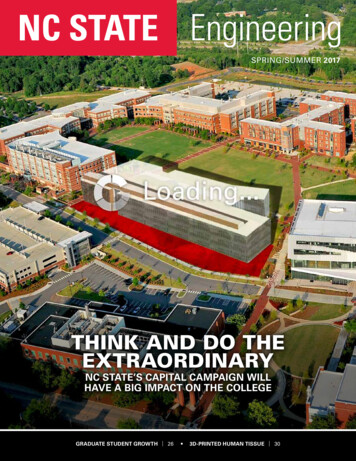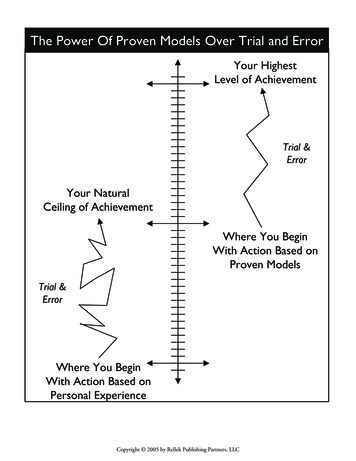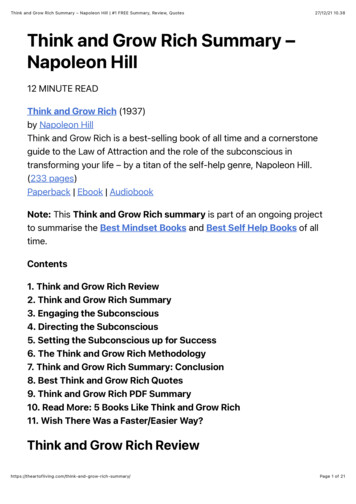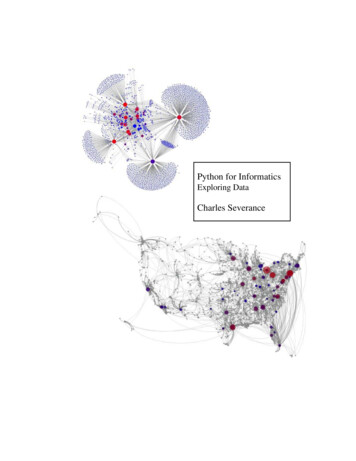
Transcription
SPRING/SUMMER 2017THINK AND DO THEEXTRAORDINARYNC STATE’S CAPITAL CAMPAIGN WILLHAVE A BIG IMPACT ON THE COLLEGEGRADUATE STUDENT GROWTH 26 3D-PRINTED HUMAN TISSUE 30
A LAB FOR LOADSTesting the effect of loading on large structures has longbeen a part of the teaching curriculum and researchprogram in the Department of Civil, Construction, andEnvironmental Engineering (CCEE).In this photo, taken around 1949, Dr. Charles R. Bramer,right, works on an investigation of wood truss membertension splices joined with split-ring connectors usingthe department’s universal testing machine. The photowas taken in the department’s former structures andmaterials lab located in “old” Mann Hall, now the eastwing of Daniels Hall on North Campus.The machine, manufactured by Baldwin-SouthwarkCorporation in 1947, could be used for either tension orcompression testing.While the control system that works with it has beenreplaced several times, the vertical frame shown in thephoto is still used in undergraduate teaching labs in room100 of “new” Mann Hall, built in 1962 andCCEE’s current home. When the departmentmakes the move in the next few years tothe planned Engineering Building Oval onNC State’s Centennial Campus, the versatiletesting frame is expected to go with it.Bramer taught in the Department of CivilEngineering from 1930 to 1975. He wasacting head of the department in 194849 before Dr. Ralph Fadum’s hiring asdepartment head in 1949, and again in 196265 after Fadum became dean of engineeringin 1962.Today, CCEE faculty members and studentscan test large structures in the ConstructedFacilities Laboratory (CFL) on CentennialCampus. The idea for the CFL, one of thepremier facilities of its kind in the UnitedStates, started in the late 1970s with adiscussion between Dr. Paul Zia, then thedepartment head in civil engineering, andDr. Larry Monteith, the dean of engineering.Zia identified a need for large-scalestructural testing in a new lab that wouldprovide space that the basement of MannHall could not. Gov. James B. Hunt Jr.’sdecision in 1983 to designate state land forthe university to create Centennial Campusprovided the space needed for the College toexpand its research facilities.Opened in 1996, the CFL now hosts projectsin collaboration with researchers fromaround the globe.Learn more about the CFL on page 16. It’sthe focus of this issue’s In Our Labs feature.2 www.engr.ncsu.edu
contentsSPRING/SUMMER 2017FEATURES16 IN OUR LABSExplore the spaces where our engineering faculty members work.In this issue, visit the Constructed Facilities Laboratory.18 L ENDING A HELPING HANDIndustry Expansion Solutions (IES) helps manufacturers, healthcare providersand government agencies improve.1622 A NEW GENERATION FOR NUCLEARThe Department of Nuclear Engineering is broadening its research scope.26 G RADUATE GROWTHThe College’s efforts to grow graduate student enrollment pay large benefits.30 P RINTABLE YOUResearchers in industrial and systems engineering are furtheringadvancements in 3D tissue printing.22DEAN Dr. Louis A. Martin-VegaADVISORY BOARDDr. John Gilligan, Distinguished University Professor of NuclearEngineering and Executive Associate Dean of EngineeringBrian Campbell, Assistant Dean for Development and College Relations,Executive Director of the NC State Engineering Foundation, Inc.Len Habas (EE ’66), President, Board of Directors, NC StateEngineering Foundation, Inc.Lora F. Bremer, Executive Director of Major Gifts and CampaignPlanning, NC State Engineering Foundation, Inc.EDITOR Jennifer CoxSR. ASSOCIATE EDITOR Brent LancasterASSISTANT EDITOR Darsee HeathMAGAZINE DESIGN DIRECTOR Candice WallaceASSISTANT GRAPHIC DESIGNERS Jacob Fremderman, Faith FurloughCONTRIBUTING WRITERS Brian Campbell, Abigail Keller, Erin Scanlon,Matt Shipman, Ken TateIMAGES Department of Computer Science, North Carolina StateUniversity; Julie Williams Dixon; Marc Hall; Darsee Heath; RashidaHodge; iStock; Rebecca Kirkland; Dr. Young Moo Lee; Dr. LouisMartin-Vega; MEDIC; Praxair Inc.; Sam Roberts; Dr. Spencer Smith;Special Collections Research Center, North Carolina State UniversityLibraries; Roger Winstead; Junjie ZhaoOFFICE OF THE DEANCollege of EngineeringCampus Box 7901, NC State UniversityRaleigh, NC 27695-7901919.515.2311www.engr.ncsu.eduNC STATE ENGINEERING FOUNDATION, INC.Campus Box 7901, NC State UniversityRaleigh, NC CHANGE OF ADDRESS? Visit www.engr.ncsu.edu/alumni-friends orsend address corrections to alumnianddonor records@ncsu.edu; orcall 919.515.7458, toll free: 866.316.4057.NC State University is an equal opportunity and affirmative actionemployer and is dedicated to equality of opportunity within itscommunity. Accordingly, NC State University does not practice orcondone discrimination, in any form, against students, employees, orapplicants on the grounds of race, color, national origin, religion, sex,sexual orientation, age, veteran status, or disability. NC State Universitycommits itself to positive action to secure equal opportunity regardlessof those characteristics. 2017. This document was produced by the NC State EngineeringFoundation, Inc. and Engineering Communications. No state funds wereused; 60,000 copies of this document were printed at a cost of 26,239on recycled paper.NC STATE ENGINEERING 1
Q&AQUESTIONS FORCHASE BEISELCRISPR-Cas is a genome editing tool that is making headlines forits potential impacts in medicine, agriculture and other areas. Dr.Chase Beisel, assistant professor in the Department of Chemicaland Biomolecular Engineering (CBE), is working with colleaguesacross NC State’s campus to determine how the system works andits potential benefits. Beisel joined the CBE faculty in 2011 after apostdoctoral fellowship at the National Institutes of Health.What is a CRISPR-Cas system?It is an adaptive immune system in bacteria that fends off bacterial viruses and othergenetic invaders. While our adaptive immune systems use protein antibodies to recognizeinvaders, CRISPR-Cas systems use RNA as the recognition element. It is remarkablyeasy to design and use these RNAs along with the system’s Cas proteins, which hasspurred the development of tools that are revolutionizing biotechnology and medicine.As researchers learn more about it, what are the possible uses?The major use currently being explored is genome editing, whether to reverse geneticdiseases in humans, improve crop plants, engineer microbial chemical factories, orcombat disease vectors and agricultural pests. There are many other applications too,such as using CRISPR as an antimicrobial agent, an antiviral agent, or as a diagnostic tool.What kinds of human diseases are we talking about?The most immediate focus is on immunotherapy, or genetically augmenting our immunecells to recognize certain diseases such as cancer. There is also a concerted effort toaddress diseases that have a single causative mutation, such as muscular dystrophy.How are you using it in your research?We are exploring the natural functions of CRISPR-Cas systems and how these systemscan be used as antimicrobial agents. As an antimicrobial, CRISPR can be programmed toselectively kill some bacteria such as pathogens while sparing others such as beneficialbacteria. It also acts separately from common mechanisms of multi-drug resistance andcould provide a way to combat antibiotic-resistant infections.When you think about where research on CRISPR-Cas systems is going, what isthe most impactful use you can imagine?I am most intrigued by the use of CRISPR for genetic pest management. CRISPR canhelp spread genes through a wild pest population that either eliminates the pest or makesit less pest-like, such as genes that make it harder for mosquitos to carry the causativeagent of malaria. The potential of these technologies is incredible, although they raisequestions about controlling gene spread and obtaining public consent.Can you give us a sense of how important the development of this tool is to thefuture of your field of study?It is hard to understate the growing importance of CRISPR in my broad field of syntheticbiology let alone biotechnology. CRISPR greatly accelerates genome editing and allowsresearchers to do what was otherwise thought extremely difficult or even impossible.CRISPR is becoming an essential tool used in almost every lab, and any labs that fail toadopt it are at a tremendous disadvantage.2 www.engr.ncsu.edu
FROM THEDEANNC State has embarked on a five-year, 1.6-billion fundraising campaign,Welcome to the spring/summer issue of the NC Statecalling on alumni and friends to help theEngineering magazine. This issue celebrates the launch ofUniversity accomplish the extraordinary.Think and Do the Extraordinary, The Campaign for NCThink and Do the Extraordinary: TheState. Launched during the 2016 Homecoming Weekend,Campaign for NC State is the largestthis capital campaign is critical for the future success of oursuch effort in the University’s history.College and University. Without the support of our alumniLOUIS A. MARTIN-VEGAUniversity launches Thinkand Do the ExtraordinarycampaignThis campaign is the vital next step forand friends, NC State and the College of Engineering cannotthe College, as it continues an upwardcontinue to provide the highest quality education and researchtrajectory toward a stated goal ofenvironment for our students and faculty.becoming the leading public college ofengineering in the country and one ofOur primary campaign focus continues to be our next marquee building — Engineeringthe premier colleges of engineering inBuilding Oval. Thanks to the Connect NC bond, the University and diligent efforts of ourthe world.the NC State Engineering Foundation, we have already raised 117 toward the goal of 154The money raised will help themillion. We still need to raise 37 million to be able to break ground on EB Oval in 2018.College fund scholarships for deservingYou can learn more about EB Oval and opportunities to help us make it a reality on page 20.students, attract more recognizedfaculty members through namedOur campaign priorities also focus on supporting the mission and vision of our strategicprofessorships and enhance theplan — support for world-class infrastructure, professorships, fellowships and scholarships.programs that give our students a well-These are the foundation for building a solid future in which our students learn from therounded experience.best faculty, our undergraduates and graduate students work alongside top researchersA key component for the Collegein state-of-the-art facilities, and where students with high academic achievements andis raising private money to helpfinancial need receive the support needed to attain a highly valued degree from oursupport construction of EngineeringCollege. More information about Think and Do the Extraordinary, The Campaign for NCBuilding Oval, the future home of theState, can be found at campaign.ncsu.edu. I encourage you to learn more about how youDepartment of Civil, Construction, andcan join us in strengthening our College.Environmental Engineering; the EdwardP. Fitts Department of Industrial andFinally, we are delighted to share with you the latest US News Graduate Rankings forSystems Engineering; and the dean’sColleges of Engineering, which now have NC State Engineering ranked 25th overall amongadministration.thmore than 250 US colleges of engineering and 13 among public US engineering colleges.North Carolina voters approved 75This is our highest ranking ever and is testimony to the tremendous commitment and effortmillion in bond proceeds to help fundmade every day by our dedicated faculty, students and staff to make you, our alumni, everconstruction, and the College hasprouder of being an NC State Engineering graduate.pledged to raise 60 million in privatedonations.I hope you enjoy this issue of NC State Engineering. And as always, I encourage you to stayconnected to your College. Thank you for your support of the College of Engineering.Contact Lora Bremer, executivedirector of major gifts and campaignplanning for the NC State EngineeringSincerely,Foundation, at lora bremer@ncsu.eduor 919.513.0983, to learn how you cansupport the College. Louis A. Martin-Vega, Ph.D.NC STATE ENGINEERING 3
PACK POINTSNew cost-effective silicon carbide high voltage switch createdNC STATE RESEARCHERS havecreated a high voltage and highfrequency silicon carbide (SiC) powerswitch that could cost much less thansimilarly rated SiC power switches. Thefindings may lead to early applications inthe power industry, especially in powerconverters like medium voltage drives,solid state transformers and high voltagetransmissions and circuit breakers.Wide bandgap semiconductors, suchas SiC, show tremendous potentialfor use in medium- and high-voltagepower devices because of their abilityto work more efficiently at highervoltages. Currently though, theirhigh cost impedes their widespread4 www.engr.ncsu.eduadoption over the prevailing workhorseand industry standard — insulated-gatebipolar transistors (IGBT) made fromsilicon — which generally work well butincur large energy losses when they areturned on and off.The new SiC power switch, however,could cost approximately one-half theestimated cost of conventional highvoltage SiC solutions, says Dr. AlexHuang and Ph.D. candidate XiaoqingSong, researchers in the FREEDMSystems Center, a National ScienceFoundation-funded engineeringresearch center led by the College.Besides the lower cost, the high-powerswitch maintains the SiC device’s highefficiency and high switching speedcharacteristics. In other words, itdoesn’t lose as much energy when it isturned on or off.The power switch, called the FREEDMSuper-Cascode, combines 12 smallerSiC power devices in series to reach apower rating of 15 kilovolts (kV) and 40amps (A). It requires only one gate signalto turn it on and off, making it simpleto implement and less complicatedthan the IGBT series connection-basedsolutions. The power switch is alsoable to operate over a wide range oftemperatures and frequencies due to itsproficiency in heat dissipation, a criticalfactor in power devices.
PACK POINTS‘Nano-kebab’ fabric breaks down chemical warfare agentsRESEARCHERS HAVE CREATED afabric material containing nanoscalefibers that are capable of degradingchemical warfare agents (CWAs).Uniform coatings of metal-organicframeworks (MOFs) weresynthesized on top of thenanofibers, forming uniquekebab-like structures. TheseMOFs are what break downthe CWAs, rendering themharmless.“Current technologiesfor addressing CWAsrely on carbon-basedmaterials — but thesecarbon materials canonly adsorb hazardouscompounds, they can’tdegrade them,” saysDr. Junjie Zhao, a formerPh.D. student in chemicalengineering and lead authorof a paper on the work. “Ourgoal was to develop newmaterials that can detoxify theseCWA compounds, and we’ve beensuccessful.” The CWA degradationresearch was conducted by researchersin Dr. Gregory Parsons’ researchgroup in the Department of Chemicaland Biomolecular Engineering, andcollaborators at RTI International and theEdgewood Chemical Biological Center.“Previous research had found thatMOFs can be effective at degradingCWAs,” Zhao says. “However, MOFsnormally come in the form of a powder.We wanted to see if we could growMOFs as functional coatings onto fibers,so that they could be used in masks,filters and protective garments.”“We think that this demonstrationof well-controlled MOF thin films thatretain their chemical functionality is animportant step for personal security andhas implications for many other civilianand commercial uses,” adds Parsons.The researchers begin by depositinga thin film of titanium oxide onto a fabricmade of nanoscale fibers using a vaporphase technology called atomic layerdeposition. The titanium oxide servesas a nucleation layer, which enables theresearchers to apply various zirconiumbased MOFs onto the nanofibers in anevenly distributed way.“We found that the MOFs formed onthe nanofibers in a kebab-like structure,with the MOFs uniformly covering theentire nanofibers, like meatballs on askewer,” Zhao says.The researchers then tested theMOF-functionalized fabric against botha CWA simulant and the nerve agentsoman. They found that, when exposedto the nano-kebab fabric, the half-life ofthe CWA simulant was as brief as 7.3minutes. The half-life of the soman wasas short as 2.3 minutes.Next steps include integration ofthe MOF-nanofiber kebab structuresinto currently fielded garment and suitmaterials and evaluating the durabilityof the materials in various conditions. NC STATE ENGINEERING 5
PACK POINTSComputer science department ranks first nationally in femalefaculty members6ACCORDING TO 2014-2015 DATAfrom the American Society forEngineering Education (ASEE), NCState ranks first in the nation in thenumber of female tenure-track/tenuredfaculty in departments of computerscience within colleges of engineering.The department currently has 20 femalefaculty members — including Dr. LaurieWilliams, its interim department head— and several other female adjuncts.Noting that the department has sevenfemale faculty members who are NSFfemale faculty. It speaks highly of theculture and environment within ourdepartment.”NC State computer science isparticularly well positioned with someof the nation’s leading authoritiesin the field, including Williams, oneof the foremost researchers in agilesoftware development and thesecurity of healthcare IT applications;Dr. Carla D. Savage, a world renownedmathematician who now servesas the secretary of the AmericanCAREER Award winners and a numberconsidered to be among the leadingexperts in their field, Dr. Mladen Vouk,former department head, says, “Weare very fortunate to have attractedso many incredibly gifted and talentedMathematical Society (AMS); Dr.Nagiza Samatova, a data analyticsexpert who has conducted impactfulclimate change research; and Dr. HelenGu, whose research recently led tothe launch of InsightFinder.com, a www.engr.ncsu.educloud monitoring and system analyticsstartup.Computer science senior, studentambassador and Women in ComputerScience student chapter presidentMelissa Novitsky says the quantity andquality of female faculty members hasa significant impact on the perceptionof the department with prospectivefemale students.“It caught my attention when I wasconsidering schools,” says Novitsky.“NC State computer science appealedto me as a place I could flourish as afemale because of the incredible femalementors that we have on our faculty.It has a surprising impact on femalestudents to see representation of theirgender in the academic faculty.”
PACK POINTSTechnology would use drones and insect biobots to mapdisaster areasINSECT CYBORGS, or biobots, mayone day team with unmanned aerialvehicles (UAVS) to map disaster areasusing technology being developed atNC State.“The idea would be to release aswarm of sensor-equipped biobots— such as remotely controlledcockroaches — into a collapsed buildingor other dangerous, unmapped area,”says Dr. Edgar Lobaton, an assistantprofessor of electrical and computerengineering and co-author of twopapers describing the work.“Using remote-control technology,we would restrict the movement ofthe biobots to a defined area,” Lobatonsays. “That area would be defined byproximity to a beacon on a UAV. Forexample, the biobots may be preventedfrom going more than 20 meters fromthe UAV.”The biobots would be allowed tomove freely within a defined area andwould signal researchers via radiowaves whenever they got close to eachother. Custom software would thenuse an algorithm to translate the biobotsensor data into a rough map of theunknown environment.Once the program receives enoughdata to map the defined area, theUAV moves forward to hover overan adjacent, unexplored section. Thebiobots move with it, and the mappingprocess is repeated. The softwareprogram then stitches the new map tothe previous one. This can be repeateduntil the entire region or structure hasbeen defined, providing a map thatcould then be used by first respondersor other authorities.“This has utility for areas whereGPS can’t be used,” Lobaton says. “Astrong radio signal from the UAV couldpenetrate to a certain extent into acollapsed building, keeping the biobotswarm contained. And as long as wecan get a signal from any part of theswarm, we are able to retrieve data onwhat the rest of the swarm is doing.” NC STATE ENGINEERING 7
PACK POINTSNew technology uses electricity to track water, ID potentialproblems in concreteSLOW DRIPS can lead to largeheadaches. That’s why researchersfrom NC State and the University ofEastern Finland have developed a newtechnique for tracking water in concretestructures — allowing engineers toidentify potential issues before theybecome big problems.“When we think about construction— from bridges and skyscrapers tonuclear plants and dams — they allrely on concrete,” says MohammadPour-Ghaz, an assistant professor ofcivil, construction, and environmentalengineering and lead investigator on theproject. Tracking concrete degradation isessential to public safety, and the culpritbehind concrete degradation is water.8 www.engr.ncsu.eduWater contributes to the degradationby itself, or it can carry other chemicals— like the road salt used on bridges— that can expedite corrosion ofboth concrete and its underlying steelreinforcement structure.“We have developed a technologythat allows us to identify and trackwater movement in concrete usinga small current of electricity that isfaster, safer and less expensive thanexisting technologies — and is alsomore accurate when monitoring largesamples, such as structures,” Pour-Ghazsays. “The technology can not onlydetermine where and whether wateris infiltrating concrete, but how fast itis moving, how much water there is,and how existing cracks or damage areinfluencing the movement of the water.”Previous technologies for assessingwater in concrete relied on X-raysor neutron radiation, but both havesignificant limitations. X-rays offer onlylimited penetration into concrete, makingit impossible to use with large samplesor on structures. Neutron radiation ismore accurate, but it also has limitedpenetration, is expensive and poseshealth and safety risks.“Our electrical imaging approach issomething that you could use in thefield to examine buildings or bridges,which would be difficult or impossibleto do with previous technologies,”Pour-Ghaz says.
PACK POINTSNC State startup works to enhance the medical field as well asthe communityDR. ANDREW DIMEO, an associateprofessor of the practice in the UNC/NCState Joint Department of BiomedicalEngineering (BME), and Dr. Jason Long,a cardio-thoracic surgeon at UNC,started with a spin off idea.After receiving a 10,000 grantfrom the Lineberger Cancer Center,they launched the Medical InnovatorsCollaborative (MEDIC) in summer2015. Today, MEDIC has a physicallocation at the Frontier, in the ResearchTriangle Park, for two years thanks to an 85,000 Catalysts for Innovation grantawarded last fall.“It’s given us a place to call home,”said Tim Martin, NC State BME gradand co-founder and acting president ofMEDIC.The grant has helped legitimize MEDIC,according to DiMeo.“We have a long history of innovativeideas that come out of the classroomand the huge majority of them are reallycool ideas sitting on shelves. I’m certainthis would be one of those cool ideassitting on a shelf if it wasn’t for theCatalysts grant.”MEDIC works to provide assetassessment and development, innovationtraining, industry relevant professionalseminars and student internships. The goalis to create a medical device hub known forproviding better, more mature technologiesbased on student and industry projects thatlead to improving the quality of medicaldevices, which will hopefully lead to morestartups and more jobs.“It’s really important for us to be anenhancement to the community; wewant for (MEDIC) to be a reason tocome to NC State and to the surroundingarea,” DiMeo said.Currently, the collaborative is workingon four projects with three more slatedto begin this spring.DR. ANDREW DIMEO, THIRD FROM LEFT, AND ANDY TAYLOR, FOURTH FROM LEFT, DURING A CATALYSTSFOR INNOVATION GRANT ANNOUNCEMENT.One of the current projects startedwith a mother looking for help. Themother of MaKayla Grace called Collegeof Engineering Dean Louis Martin-Vega’soffice looking for someone to help her2-year old daughter, who suffers fromArthrogryposis multiplex congenita(AMC), a congenital contracture diseasethat locks a patient’s joints into place.She can only move her left arm at theshoulder.The call was routed to DiMeo,and the team at MEDIC respondedby assembling a group of NC Stateundergraduate and graduate studentinterns. Through the collaborativemodel MEDIC is setting up, they areworking to provide assistance that otherorganizations don’t have the bandwidthfor.“We’re working with them to developsomething that will help her get somemotion back in her arm — just enoughso she can play around — as kidsshould,” said Andy Taylor, BME grad,co-founder and program director atMEDIC.Other projects include creating anattachment for an existing wheel chair tohelp an Alzheimer’s patient with limitedmobility to move his feet, workingwith neonatologists at UNC Hospitalto develop a simulator for insertingchest tubes, and continuing the workfrom Taylor’s senior design class on aphototherapy device for infants withneonatal jaundice.With the slew of projects thecollaborative works on, MEDIC makesa point of hiring students not onlyfrom NC State, but also UNC ChapelHill, Duke, and any other local collegewith students interested in acquiringbiomedical device product developmentexperience. “We are making productdevelopment education a big part of thefocus,” said Taylor.“MEDIC’s projects are the key to ourmodel — addressing the gap in productdevelopment in the healthcare spacewith student teams from universitiesto give them an experience that theymay not be able to get in the traditionaleducation path,” said Martin. NC STATE ENGINEERING 9
PACK POINTSBTEC will play prominent role in new manufacturing centerTHE BIOMANUFACTURING Trainingand Education Center (BTEC) is partof a new initiative aimed at advancingU.S. leadership in the biopharmaceuticalsector.The National Institute for Innovationin Manufacturing Biopharmaceuticals(NIIMBL) is supported with a fiveyear, 70 million grant from the U.S.Department of Commerce and at least 129 million from a consortium of 150companies, educational institutions,research centers, coordinating bodies,non-profits and ManufacturingExtension Partnerships across thecountry.NIIMBL is the 11th institute in the10 www.engr.ncsu.eduoverall Manufacturing USA initiative,and NC State is involved with four ofthem.In addition to advancing U.S.leadership in the biopharmaceuticalfield, NIIMBL is also tasked withfostering economic development,improving medical treatments andensuring a qualified workforceby collaborating with educationalinstitutions to develop new trainingprograms matched to specificbiopharma skill needs.“This is a fantastic opportunityfor BTEC, NC State and the stateof North Carolina,” says Dr. RubenCarbonell, who will serve as the chieftechnology officer for NIIMBL and isthe director of BTEC. “BTEC will playa key role in workforce development,including academic and industrytraining programs, as well as processand analytical services and research,”adds Carbonell, who is also the FrankHawkins Kenan Distinguished Professorof Chemical Engineering.NIIMBL will be coordinated by theUniversity of Delaware, in conjunctionwith Commerce’s National Instituteof Standards and Technology (NIST).The consortium is also establishing anew nonprofit organization called USABio LLC to administer the cooperativeagreement with NIST.
PACK POINTSthey wanted to lookat activity in neuronsacross multiple areasat the same time.To do that, theresearchers useda two-photonmicroscope, whichimages fluorescence.In this case, it couldbe used to see whichneurons “light up”when active.The problem wasthat conventional twophoton microscopysystems could onlylook at approximatelyone square millimeterof brain tissue at atime. That made ithard to simultaneouslycapture neuron activityin different areas.This is where Dr.Michael Kudenovcomes in. An assistantprofessor of electricaland computerengineering at NCState, Kudenov’s areaof expertise is remoteimaging. His workfocuses on developingnew instruments andsensors to improvethe performance of technologies used ineverything from biomedical imaging toagricultural research.After being contacted by the UNCresearchers, Kudenov designed a seriesof new lenses for the microscope thatwere incorporated into an overall twophoton imaging system that allowedthe researchers to scan much largerareas of the brain. Instead of capturingimages covering one square millimeterof the brain, they could captureimages covering more than 9.5 squaremillimeters. Neuroscientists and an engineer take a closerlook at the brainIN A PARTNERSHIP meldingneuroscience and electrical engineering,researchers from UNC-Chapel Hilland NC State have developed a newtechnology that will allow neuroscientiststo capture images of the brain almost 10times larger than previously possible —helping them to better understand thebehavior of neurons in the brain.Nervous systems are complex. Afterall, everything that any animal thinks ordoes is controlled by its nervous system.To better understand how complexnervous systems work, researchershave used an expanding array of evermore sophisticated tools that allowthem to actually see what’s going on. Insome cases, neuroscience researchershave had to create entirely new tools toadvance their work.This is how an electrical engineeringresearcher ended up co-authoring aNature Biotechnology paper with a groupof neuroscientists.A UNC-Chapel Hill research teamwanted to be
administration. North Carolina voters approved 75 million in bond proceeds to help fund construction, and the College has pledged to raise 60 million in private donations. Contact Lora Bremer, executive director of major gifts and campaign planning for the NC State Engineering Foundation, at lora_bremer@ncsu.edu











